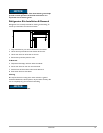
8 u-line.com
Looking Behind the Label
To most, wine is a delicious mystery. We purchase it, uncork it, and
savor its taste and beauty. But there is so much more to true wine
appreciation. Many secrets are simply too good to keep bottled up.
Wine Selections Suggestions
Selecting the right wine for the right occasion can sometimes be a
seemingly awkward or difficult task for the beginning wine enthusiast.
We would therefore like to present you with a few suggestions which
may provide a little more confidence and enjoyment when choosing
and serving your wines.
When selecting wines, keep an open mind and do not be afraid to be
adventurous. Do not view the subject of wine so seriously it
discourages you from learning and discovering for fear of
embarrassment if something is incorrect. Wine is best viewed as a
hobby and enjoyed.
When assembling your collection, try not to become obsessed with
“Vintages.” Although a chart can be a useful tool, generalizations
about a specific year have led more than one collector to
disappointment. Often an “Off Year” will provide a better value and
more drinking enjoyment.
The primary guideline to the subject of wine is your own palate. Do
not be afraid to make mistakes. Experiment, discover, but most of all,
enjoy yourself and your new U-Line product.
Guide To Common Styles Of Wine
Matching Food and Wine
Although there are no hard fast rules for matching wine to food,
observe some guidelines. Delicate dishes should be accompanied by
lighter more delicate wines. Full-flavored foods should be matched
with fuller-bodied wines.
As a general rule, one should aim to ascend in flavor and quality of
wines served.
Any step back in quality will be noticed. If a fine wine is tasted prior
to a lesser wine, many of the fine wine’s subtle qualities may be
missed.
Common Food and Wine Matches
A Toast to Wine Truths
Like the grapes themselves, many wine myths have been cultivated
over the centuries.
Myth 1: Most wines taste better when aged.
Truth: In fact, less than 5% of wines produced today are meant to be
aged. Most wines are crafted to be consumed within the first one to
two years.
Myth 2: Wines should be uncorked and decanted allowing them to
“breathe.”
Truth: To breathe or not breathe? While it is better to allow a young
tannic Red to breathe in a glass or decanter to soften the tannins, an
old Red reaches a stage in its life where it should be enjoyed soon
after opening. Allow an old Red to breathe for a short time to
dissipate any off odors. Most white wines can be served, ideally, 10-
15 minutes after opening.
Myth 3: When age worthy wines peak, they must be consumed
almost immediately.
Truth: Most great wines reach a plateau period rather than a peak.
Great Bordeaux’s may have as much as a 10-year plateau before
fading.
Myth 4: Wine color does not change with aging.
Truth: As red wines age they get lighter in color while whites get
darker.
U-Line Wine Guide
Red Wines
Full-Bodied Dry California
French
Italian
Zinfandel, Cabernet
Rhone, Chateauneuf-du-
Pape
Barbaresco, Barolo
Medium-Bodied Dry California
French
Pinot Noir
Bordeaux, Burgundy
Light-Bodied Dry French
Italian
Beaujolais
Chianti, Bardolino
White Wines
Full-Bodied Dry California
French
Chardonnay
Montrachet, Meursault
Puligny-Montrachet
Medium-Bodied Dry California
French
Sauvignon-Blanc
Pouilly-Fuisse, Sancerre,
Vouvray, Graves
Light-Bodied Dry French Chablis, Muscadet, Pouilly-
Fume
Full-Bodied, Very Sweet Germany
French
Hungary
Beerenauslese
Sauternes
Tok a y
Medium-Bodied, Semi-
Sweet
California
Germany
Gewurtztraminer
Liebfraumilch
Light-Bodied Off Dry Germany Rhine, Mosel, Riesling
Serve a: Before a:
DRY wine SWEET wine
WHITE wine RED wine
YOUNG wine OLD wine
LIGHT-BODIED wine FULL-BODIED wine
Foods Wines
Fish, Shell Fish, Crab, Oysters Dry White Wines, Light Sparkling
or Extra Dry Champagne
Beef, Venison Full-Bodied Red Wines
Pork, Veal, Lamb and Poultry Light-Bodied Red Wines
Fruit Sweet White and Sparkling Wines


















